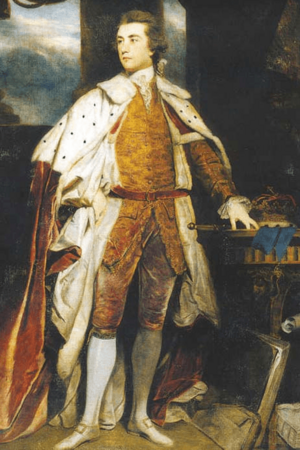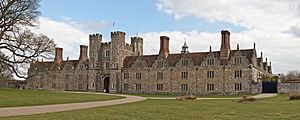John Sackville, 3rd Duke of Dorset facts for kids
Quick facts for kids
The Duke of Dorset
|
|
|---|---|
 |
|
| Captain of the Yeomen of the Guard | |
| In office 1782 – April 1783 |
|
| Monarch | George III |
| Prime Minister | The Duke of Portland |
| Preceded by | The Viscount Falmouth |
| Succeeded by | The Earl of Cholmondeley |
| Lord Steward of the Household | |
| In office 1789–1799 |
|
| Prime Minister | The Earl of Shelburne |
| Preceded by | The Duke of Chandos |
| Succeeded by | The Earl of Leicester |
| Personal details | |
| Born | 24 March 1745 |
| Died | 19 July 1799 (aged 54) |
| Spouse |
Arabella Cope
(m. 1790) |
| Children | 3, including George |
| Parents | Lord John Sackville Lady Frances Leveson-Gower |
John Frederick Sackville, 3rd Duke of Dorset (born March 25, 1745 – died July 19, 1799) was an important British nobleman. He was the only son of Lord John Philip Sackville. His mother was Lady Frances Leveson-Gower.
He became the Duke of Dorset in 1769. This happened after his uncle, Charles Sackville, 2nd Duke of Dorset, passed away. John Frederick Sackville also became a Knight of the Garter (KG). This is a very special award in England.
He served as the British Ambassador to France starting in 1784. He returned to England in August 1789. This was because the French Revolution was starting to get serious.
Dorset was well-known for his love of cricket. He was a good player and also helped support the sport. He also enjoyed billiards and tennis.
Contents
His Public Service
John Frederick Sackville had an important role in British politics. In 1768, he became a Member of Parliament for Kent. He held this position until 1769. That's when he became the 3rd Duke of Dorset.
He was also appointed Lord Lieutenant of Kent in 1769. This was a key local leadership role. He kept this job until 1797.
In 1783, he became the Captain of the Yeomen of the Guard. This is a group of royal bodyguards. The next year, he moved to Paris. After returning to England, he served as Lord Steward of the Household. He held this position until his death.
A Passion for Cricket
John Sackville first showed his talent for cricket at Westminster School. He later joined the Hambledon Cricket Club. This club, located in Hambledon, Hampshire, was the best cricket club at that time.
He played alongside other famous cricketers. These included Sir Horatio Mann and Lord Tankerville. Lord Tankerville was his main rival in the sport.
Dorset was known as a fierce competitor. In 1773, the Morning Post newspaper wrote about his strong play. It mentioned how he would hit the ball hard, even if players got too close.
In the same year, Dorset gave the Vine Cricket Ground in Sevenoaks, Kent, to the town. He charged a very small rent for it. This is one of England's oldest cricket grounds. The first big cricket match reported nationally happened here in 1734. The "Gentlemen of Kent" played against the "Gentlemen of Sussex."
Today, the Sevenoaks Town Council still uses the Vine Cricket Club. The rent is now two peppercorns. They also give the Lord Sackville one cricket ball each year on July 21st, if asked.
In 1782, the Morning Chronicle newspaper praised Dorset. It said he was one of the few noblemen who enjoyed both modern luxury and traditional English sports.
Supporting cricket was costly for Dorset. In 1783, the Whitehall Evening Post reported it cost him £1,000 a year. This was a lot of money back then. However, it was less than what some others spent on horse racing. The report also said Dorset was unmatched in cricket, tennis, and billiards among noblemen.
When Dorset became the British ambassador to France, he tried to make cricket popular there. The Times newspaper noted that horse racing was losing popularity in France. Cricket, thanks to Dorset, was starting to take its place. In 1786, The Times reported on a cricket match in the Champs-Elysées. It said Dorset was the most skilled player. The French, however, found the game too physically demanding.
Serving as Ambassador to France
In 1784, Dorset moved to Paris. He served as the British ambassador to France. His official title was Ambassador Extraordinary and Plenipotentiary. This means he had full power to represent Britain.
On July 16, 1789, just two days after the Storming of the Bastille, Dorset sent a report. He wrote to Francis Osborne, 5th Duke of Leeds, who was the Secretary of State for Foreign Affairs. Dorset described the event as a huge revolution. He noted that it happened with very few lives lost, considering its size. He believed France was now a free country. He also thought the King's power would be very limited.
There is no official record of Dorset being called back from France. However, he was in Paris from early 1789 until August 8 of that year. He then left on leave and returned to England. He did not go back to France.
His Embassy Secretary, Lord Robert Stephen FitzGerald, temporarily took his place. Dorset's official replacement was Earl Gower. Earl Gower took over on June 20, 1790. Dorset's role as ambassador officially ended on June 29, 1790.
After returning to England, Dorset continued his public life. He served as the Steward of the Royal Household.
Family Life
In 1790, after coming back from France, Dorset got married. He married Arabella Diana Cope, who was 23 years old. She was the daughter of Sir Charles Cope, 2nd Baronet.
Dorset and Arabella had one son together. His name was George John Frederick. He was born on November 15, 1793. They also had two daughters: Lady Mary Sackville, born in 1792, and Lady Elizabeth Sackville, born in 1795.
The Duke passed away in 1799 at the age of 54. He left his estates to his wife for her lifetime. This meant Arabella became very wealthy. From 1799 until her death in 1825, she managed the Sackville estates and money. She held them in trust for their young son. She remarried in 1801 to Charles Whitworth, who became the 1st Earl of Whitworth. They did not have more children.
George John Frederick became the 4th Duke of Dorset when his father died. He was only 6 years old. He spent his life under the care of his mother and stepfather. He died at age 21 in a riding accident in Ireland. He had just become engaged to Lady Elizabeth Thynne.
Even though the dukedom went to his cousin, Charles, Viscount Sackville, the estates stayed with Arabella. After her death in 1825, Knole House went to her elder daughter, Mary. Buckhurst and other lands went to her younger daughter, Elizabeth.
Lady Mary Sackville married twice. She had no children. She left her estates to her sister, Countess De La Warr, and her heirs.
Countess De La Warr was given the title Baroness Buckhurst. This title was later inherited by her younger son, Reginald. He is an ancestor of the current Earl De La Warr. Another family line from this lady is the Barons Sackville. This title was created because they lost the Buckhurst title.
The 1st Baron Sackville inherited Knole House. This was according to the will of Mary, Countess of Plymouth. His nephew, the 3rd Baron Sackville, was the father of the writer Vita Sackville-West. She created a famous garden at Sissinghurst. Both Knole House and Sissinghurst have been given to the National Trust.
Images for kids




